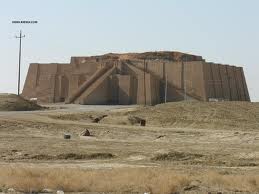
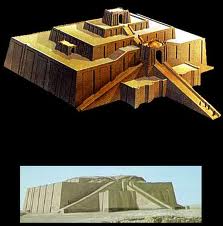
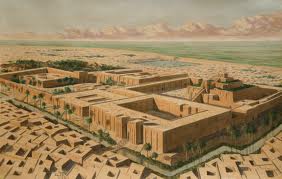
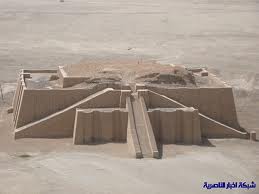
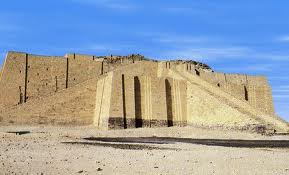
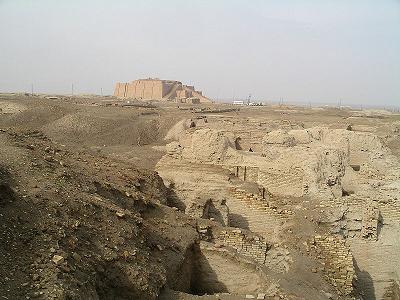
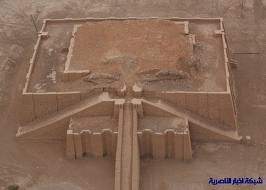
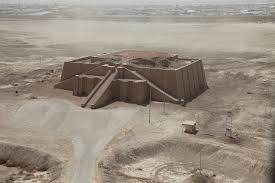
Text source: Wikipedia
Ur
Ur (Sumerian: Urim;[1] Sumerian Cuneiform: URIM2KI or URIM5KI;[2] Akkadian: Uru[3]) was an important Sumerian city-state in ancient Mesopotamia located at the site of modern Tell el-Muqayyar in Iraq's Dhi Qar Governorate.[4] Once a coastal city near the mouth of the Euphrates on the Persian Gulf, Ur is now well inland, south of the Euphrates on its right bank, 16 kilometres (9.9 mi) from Nasiriyah.[5] The city dates from the Ubaid period circa 3800 BC, and is recorded in written history as a City State from the 26th century BC, its first recorded king being Mesh-Ane-pada. The city's patron deity wasNanna (in Akkadian Sin), the Sumerian and Akkadian (Assyrian-Babylonian) moon god, and the name of the city is in origin derived from the god's name, URIM2KI being the classical Sumerian spelling of LAK-32.UNUGKI, literally "the abode (UNUG) of Nanna (LAK-32)".[6] The site is marked by the ruins of the Ziggurat of Ur, which contained the shrine of Nanna, excavated in the 1930s. The temple was built in the 21st century BC (short chronology), during the reign of Ur-Nammu and was reconstructed in the 6th century BC by Nabonidus, (the Assyrian born last king of Babylon) in the 6th century BC. The ruins cover an area of 1,200 metres (3,900 ft) northwest to southeast by 800 metres (2,600 ft) northeast to southwest and rise up to about 20 metres (66 ft) above the present plain level.[7] History
Archaeologists have discovered evidence of an early occupation at Ur during the Ubaid period. These early levels were sealed off with a sterile deposit that was interpreted by excavators of the 1920s as evidence for the Great Flood of the book of Genesis and Epic of Gilgamesh . It is now understood that the South Mesopotamian plain was exposed to regular floods from the Euphrates and the Tigris, with heavy erosion from water and wind, which may have given rise to the Mesopotamian and derivative Biblical Great Flood beliefs.[8] The further occupation of Ur only becomes clear during its emergence in the third millennium BC (although it must already have been a growing urban center during the fourth millennium). The third millennium BC is generally described as the Early Bronze Age of Mesopotamia, which ends approximately after the demise of the Third Dynasty of Ur in the 21st century BC.
Third millennium BC (Early Bronze Age) Mesopotamia in the 3rd millennium BC.
There are two main sources which inform scholars about the importance of Ur during the Early Bronze Age. The first is a large body of cuneiform documents , mostly from the empire of the so-called Third Dynasty of Ur at the very end of the third millennium. This was the most centralized bureaucratic state the world had yet known. Concerning the earlier centuries, the Sumerian King List provides a tentative political history of ancient Sumer. The second source of information is archaeological work in modern Iraq. Although the early centuries (first half of the third millennium and earlier) are still poorly understood, the archaeological discoveries have shown unequivocally that Ur was a major urban center on the Mesopotamian plain.
Especially the discovery of the Royal Tombs have confirmed its splendour. These tombs, which date to the Early Dynastic IIIa period (approximately in the 25th or 24th century BC), contained immense amounts of luxury items made out of precious metals, and semi-precious stones all of which would have had to been imported from long distances (Iran, Afghanistan, India, Asia Minor, the Persian Gulf).[7] This up to then unparalleled wealth is a testimony of Ur's economic importance during the Early Bronze Age.[9]
Archaeological research of the region has also contributed greatly to our understanding of the landscape and long-distance interactions that took place during these ancient times. We know that Ur was the most important port on the Persian Gulf, which extended much further inland than it does today. All the wealth which came to Mesopotamia by sea had to pass through Ur.[citation needed]
So far evidence for the earliest periods of the Early Bronze Age in Mesopotamia is very limited. Mesh-Ane-pada is the first king mentioned in the Sumerian King List, and appears to have lived in the 26th century BC. That Ur was an important urban centre already then seems to be indicated by a type of cylinder seal called the City Seals. These seals contain a set of proto-cuneiform signs which appear to be writings or symbols of the name of city-states in ancient Sumer. Many of these seals were found in Ur, and the name of Ur is prominent on them.[10]
Text source: Wikipedia
You are welocome to send your comments and proposals as well any useful photos, documents, links for website update using our following address:
الصفحة ترحب باية ملاحظات او مقترحات كما تتطلع لاستلام اية صور او وثائق او روابط مفيدة لتحديثها عبر المراسلة على العنوان الالكتروني التالي
info@uruk-warka.dk
Other updates ... تحديثات اخرى
Ur Photos - صور من اور
CITY-STATES OF ANCIENT - SUMER ... دول المدن في سومر
Ur Devlopment .... تطور مدينة اور
Ur Report .... تقرير عن مدينة اور